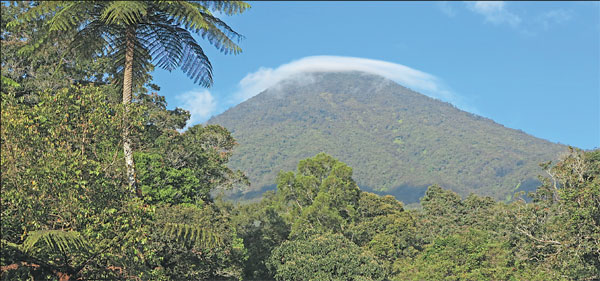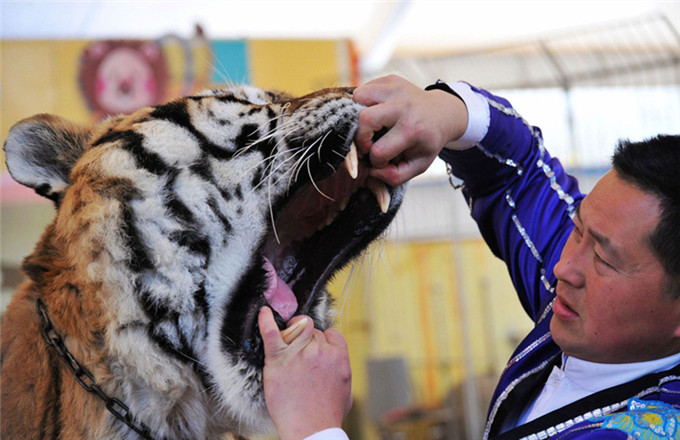In the mists of gede-pangrango
|
Clouds curl along the top of Mount Pangrango in Gede-Pangrango National Park in Cibodas.Photos By Chen Liang / China Daily |
A four-day jaunt in Java features towering trees, birds and other exotic wildlife, Chen Liang reports Chen Liang
When many Chinese think of Indonesia their minds fly to the island of Bali. To the better informed and the more traveled the sprawling archipelago looms a lot larger, and in addition to Bali the island of Lombok and the ancient city of Yogyakarta in Java may spring to mind. Even the country's capital, Jakarta, has long been off the radar for Chinese tourists.
It may come as a surprise that Indonesia offers tourist visas to Chinese citizens free of charge, which is just one reason, even if among the least important, why the country ought to appeal to Chinese travelers.
When I first went to Indonesia five years ago, I visited Yogyakarta and Bali. My second trip last month took me to the remote Maluku Islands, a three-hour flight from Jakarta, but before settling down in the the Malukus for a few days I spent three days in West Java.
As a nature lover I prefer natural attractions such as forests and mountains to modern cities or historical towns. Only 60 kilometers south of Jakarta, Gunung Gede-Pangrango National Park seemed a natural choice. The twin volcanoes of Gunung (Mount) Gede and Gunung Pangrango are located in the park, which luxuriates in 150 square km of tropical forest that is home to about 250 species?? of birds, about 30 indigenous to Java, and mammals such as leopards, Javan gibbons and Javan langurs (also known as ebony leaf monkeys).
So after arriving in Jakarta from Ternate, one of the Maluku islands, in the morning, I hired a taxi to take me to Cibodas, a village at the foot of the national park, so I would have more time up my sleeve for my ultimate destination. I reached Freddy's Homestay in Cibodas, in which I had booked a room, about 3 pm.
The hostel has very basic rooms and a communal bathroom. After a break in the dining/sitting room and asking Freddy to prepare dinner for me at 6:30 pm I headed out to Cibodas Botanical Garden at 4 pm. The entrance, a 10-minute walk from the hostel, is beside the entrance to the national park.
The garden presented a pleasant surprise. Stretching in a broad valley at the foot of Mount Gede, it is expansive, well designed and beautiful. Everywhere you look there is a towering tree of this species or that. Flocks of birds feed in the canopies, and you know that not because you can see them - you can't - but because your ears are assaulted with the sound of their incessant chirping.
Broad lawns and overgrown shrubs cover the gentle slopes. At the bottom of the valley is a flat lake with a fountain at its center. Clean, clear water is channeled into the lake along a stream leading to Cibodas Waterfall, which tumbles down a cliff covered by different species of ferns.
Sitting under the shade of a big tree and overlooking the lake and the green valley, you can enjoy the cool breeze from the surrounding forest on the volcano of Mount Gede. For someone who has just arrived from hot and humid Jakarta, the stay in the garden can be exceptionally pleasant. Perhaps that is why the garden is so popular with families of tourists, many clearly from the Middle East.
I later discovered that the botanical garden dates back more than 150 years, founded by a Dutch botanist as a branch of the Bogor Botanical Gardens, the oldest botanical garden in Southeast Asia, with a history of nearly 200 years.
The garden is about 1,300 meters to 1,400 meters above sea level, which allows it to grow many plants exotic to Indonesia, such as huge coniferous trees from Europe and eucalyptus trees from Australia.
When I finally left the garden after sunset it had become a lot quieter, and when I arrived back at the hostel, dinner, Indonesia-style fried rice, awaited me.
Freddy and his wife are devout Muslims. He gets up at 4 am every day and prepares to go to the mosque. His wife prepares breakfast for guests, often early risers such as birdwatchers and hikers.
The next day I was one of those early birds, leaving the hostel at 5:30 and heading to the national park. I was at the ticketing office, along a road that runs past a golf course, 15 minutes later. My enthusiasm had obviously got the better of me, because no one was in the office, so I moved on.
There is just one trail that takes you to the summits of Mount Gede and Mount Pangrango and I planned to trek from the park entrance at 1,250 meters above sea level to the hot springs area at 2,150 meters. So I began the climb in darkness.
I passed Telaga Biru (Blue Lake) at 6:30 am and decided to leave the site on the lower section of the park for the following day. I walked onto a concrete boardwalk that crosses an open valley covered by dense reeds. There I could clearly see the summit of Mount Pangrango tinged by the sunrise under the blue sky. With dense forests sprawling below the volcano, the view is truly spectacular.
As there were no other visitors, I could sit on the boardwalk, watch clouds slowly moving up toward the summit and enjoy the serene moments in solitude. The boardwalk is the perfect place for view forest canopies in every direction.
Soon I found a flock of black monkeys feeding in canopies not far from the boardwalk. After checking a guidebook, I realized they are Javan langurs. I watched these energetic and creatures dexterously clamber in the treetops and gradually disappear into the forest.
Not far from the boardwalk is the junction of the main trail and a side trail to the Cibeureum Falls, which I decided to visit the next day. I followed the main trail, which climbs more steeply to the hot springs area. In the middle section of the mountain I was fortunate to encounter another primate species, grizzled langurs (leaf monkeys), which have a gray back and a white belly.
The climb gradually became more difficult, and big or small rocks that lined the trail could be dangerous to the ankles. It took about three hours to get to the hot springs area. You cannot miss it because the steamy hot springs flow over the trail.
From about there?? the trail became extremely slippery and steamy. You have to walk on a series of lichen-covered rocks and grab a rope railing to prevent yourself stepping into water or tumbling down a cliff covered with ferns and shrubs. Before traversing the treacherous part about 15 meters long I had to put my glasses into my backpack.
After that, I had a break and enjoyed the distinctive scenery in this part of the mountains. The valley in front of the hot springs reminded me of the fascinating world of Avatar in the James Cameron movie.
Trees, several with beautiful red leaves, are all towering. The trunks of these trees are overgrown with huge tree ferns, lichens and other epiphyte plants. Various orchid species blossom on trunks and branches. Steam from the hot springs floats in the moist air and gives the valley an other-world look.
Following a stream that originates from the hot springs, I arrived at a camping ground where I ate my packed lunch. I started descending about 2 pm, and it was much easier than the latter part of the ascent, but my knees were starting to ache.
I explored the lower part of the mountain the next day.
The Blue Lake turned out to be little more than a big pond by the trail, and I did not find it particularly interesting. On the other hand, the Cibeureum Falls are three waterfalls flowing down a sheer cliff and worth a close look.
The shrubs of Jimson weed or devil's trumpet (Datura stramonium) in front of the falls are pleasant to behold. Rampant with big white trumpet-shaped flowers, the shrubs act as an exotic and beautiful foreground for the waterfalls. The site is popular among Indonesian day-trippers who swim in the stream filled by the falls and picnic nearby.
Still, I prefer the upper part of the mountains, which is quieter and wilder.
My lasting regret is that I could not spend a few more days in Cibodas, during which I would have hired a guide and tried to ascend to the crater wall of Gunung Gede and watch the sunrise there.
Contact the writer at chenliang@chinadaily.com.cn



















